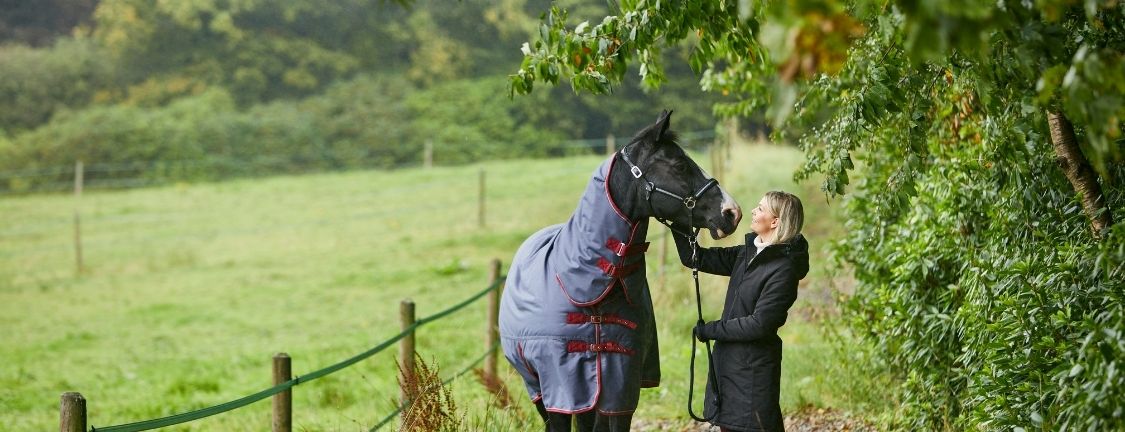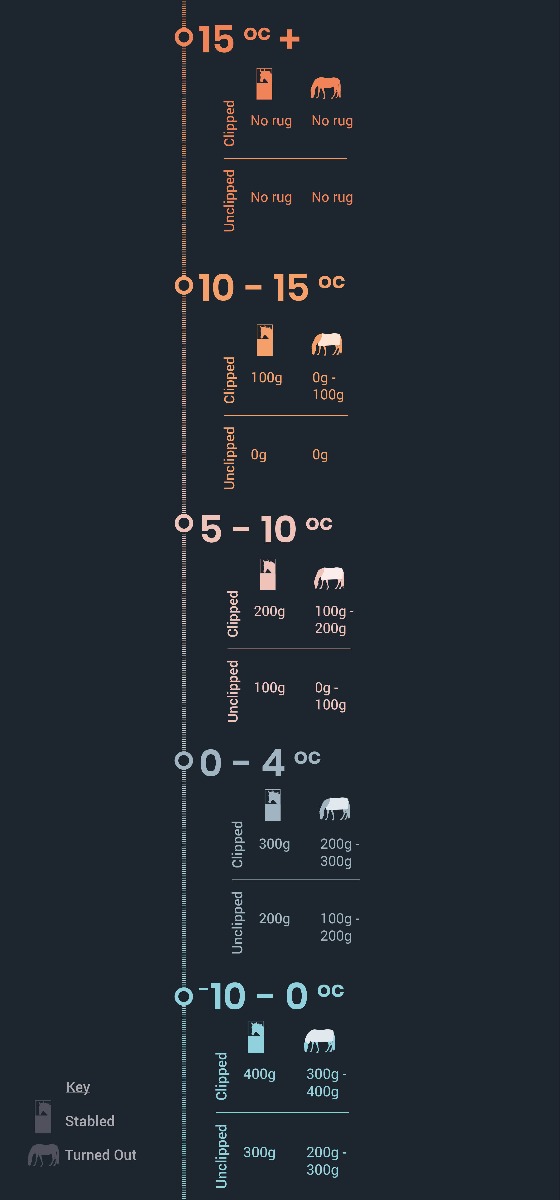
Over rugging: A Horse Rugging Guide
Do you find yourself constantly wondering what rug to put on your horse? Are you refreshing your weather app and looking up to the sky every ten minutes to find the answers? Horse rugging can, quite simply, be a constant headache for horse owners. The should I, shouldn’t I questions roll around your head every day as you try to channel your inner meteorologist and figure out what the weather will do. This horse rugging guide aims to help you make solid decisions regarding what rug your horse needs.
What is horse rugging?
A horse rug, also known as a horse blanket, is a type of coat put on a horse to stop it from getting too cold, too wet, or to protect it from flies. A horse rug is designed to cover a horse’s body from the chest to the rump, including the tops of their legs. Some horse rugs have fixed or, detachable neck covers too. Horse rugs usually have adjustable straps around the chest, two belly straps and a fillet string or leg straps to prevent the rug from slipping forwards.
A horse rug helps you keep your horse comfortable in all types of weather. Rugs need to be adjusted to match the season as well as your horse’s workload and condition.
Below are the different weights of horse rugs and what they mean:
Lightweight horse rugs
Available as turnout rugs and stable rugs, a lightweight horse rug is ideal for warmer autumn days and cooler summer nights when the temperature drops or rain is forecast. Lightweight horse rugs generally have a maximum filling of 100g and can have no filling at all. A rug with no fill would keep your horse protected from the elements while preventing overheating. They can come with or without a neck cover.
Mediumweight horse rugs
Mediumweight horse rugs are generally around 200g in weight and can come with or without a neck cover. Some mediumweight horse rugs have fixed neck covers, others are detachable, and some have a standard neck design. Mediumweight rugs are available as turnout rugs and stable rugs.
Heavyweight horse rugs
Heavyweight horse rugs keep your horse dry and warm when the cold weather strikes. Heavyweight refers to 300g and above weight rugs. Turnout rugs or stable rugs are available as heavyweight horse rugs and again there are various options when it comes to neck covers.
Horse Rugs for Spring/Summer
Myth - it is better to keep a horse warm than let them get cold
Truth – horses are extremely good at regulating their body temperature and are perfectly happy when the environmental temperature is between 5°c and 25°c (this is called their thermoneutral zone, where they can warm themselves up and cool themselves down using little additional energy).
It’s actually much easier for a horse to warm up than cool down.
So does your horse need a rug? The answer to this is, well, complicated and involves various factors that all need to be considered when deciding whether your horse needs a rug.
When considering if your horse needs a rug, it’s worth thinking about:
- The age of your horse – a veteran horse may need extra warmth to stay healthy and keep weight on.
- The workload of your horse – if your horse has a high workload and is clipped, rugging will provide extra warmth during the winter months. If your horse is not in work and has not been clipped, consider whether they need a rug.
- The health of your horse – if your horse is prone to illness, especially in the colder months, using a rug to help keep them warm can also keep illness at bay.
- The breed of your horse – some have fine skin and coats such as Thoroughbreds and Arabs. They will feel the wet and cold more than other breeds. (Remember that every horse is different, make sure your rugging plan works for your horse.)
- Protecting your horse from insects – in the summer months insects are at their peak, fly rugs help prevent biting insects getting to your horse.
- Is shelter available – if yes, and they’re roughed off for winter, a rug might not be required. Rugs are not a substitute shade and shelter in the summer months.
Do horses need rugs in winter?
The thing to remember here is not to rug your horse based on how cold you are. Horses are very good at regulating their body temperature and standing in such a way to keep them warm. Have you ever noticed how horses will turn their bottoms into the wind?
World Horse Welfare remind us that over rugging a horse could lead to discomfort, weight gain or the development of skin conditions. Winter rugs should be checked regularly to prevent slipping and unwanted pressure points which could lead to discomfort.
In addition, if an overweight horse is over-rugged it will prevent them from losing weight, this puts them at risk of laminitis. Horses in the wild have survived for centuries by gaining weight during the summer months and losing weight in the winter months. By over-rugging, we risk messing with their natural hormone levels which could lead to laminitis and other health problems.
Rugging horses in the rain
In cold, wet weather, a well-fitting horse rug will help keep your horse warm and dry. Look for a horse rug that is fully waterproof yet breathable with 600 denier fabric or more. A typical British summer often involves rain too. Many horse owners will use a lightweight turnout rug during rain showers. The important thing to remember here is to remove the rug as soon as the temperatures increase as most horses can go without rugs in the summer.
Top tip – Get your turnout rugs washed and re-proofed regularly to keep them in good condition
Do horses need rugs in summer?
Many horse owners use rugs in summer to prevent a horse’s coat from fading. Over rugging a horse is, however, a big problem in the summer months. Rugs do not keep horses cool and large-bodied animals, such as horses, take longer to cool down – using a rug on a horse in hot weather will impede this by preventing air from passing over their body. If necessary, confine your horse to shade (for example, in a stable) throughout the day with access to ad-lib forage and water.
Rugging horses in hot weather
The key thing to remember is that it’s much easier for a horse to warm up than cool down and this is where the danger lies. The biggest issue can be chilly mornings and warmer days. The horse may sweat under the thick rug put on in the morning as you whizzed to work.
Over rugging a horse could lead to overheating, and a horse that can’t cool down sufficiently will get heat stress.
What are the first signs my horse has heat stress?
- Loss of appetite
- Restless/Colic-like symptoms
- Rapid heart and breathing rate
- Lethargic
- Dehydrated
If your horse shows signs of overheating and heat stress, Paragon Equine Veterinary group in Cumbria recommend removing the rug as soon as possible and cold hosing the whole body to bring their temperature down.
If your horse is showing signs of overheating, remove the rug immediately and cold hose their body to bring their temperature down
At what temperature does my horse need a rug?
When deciding what rug to put on your horse, use this handy chart to help you figure out what rug your horse needs and when. This horse rugging guide was developed by the Masta horse rug product team.
| Stabled / Temperature | -10 - 0°c | 0 - 5°c | 5 - 10°c | 10 - 15°c | 15+°c |
|---|---|---|---|---|---|
| Stabled / Clipped | 400g | 300g | 200g | 100g | No rug |
| Stabled / Unclipped | 300g | 200g | 100g | 0g | No rug |
| Turned Out / Clipped | 300g - 400g | 200g - 300g | 100g - 200g | 0g - 100g | No rug |
| Turned Out / Unclipped | 200g - 300g | 100g - 200g | 0g - 100g | 0g | No rug |

Is my horse’s rug too heavy?
If your horse’s rug is too heavy, the first signs will be sweat, obvious irritation and rubbing. Flattened hair is also a sign a horse rug might be too heavy for your horse. The flattening of horsehair affects the horse’s natural process of insulation. This makes them less able to trap heat and insulate their body. Consider a lighter weight horse rug if your horse displays these signs.
Is my horse’s rug too light?
As mentioned previously, it’s much easier for a horse to warm up than it is to cool down. Horses stay warm through herd protection, eating forage, using natural shelters such as hedgerows (or field shelters) and by using their natural insulation. When the hairs on your horse’s coat stand on end, they are trapping heat and creating a layer of insulated body heat.
To summarise the horse rugging guide
The British weather can throw multiple curveballs in one day so being prepared is key. We hope this horse rugging guide has helped you establish when your horse needs a rug and what weight horse rug they might need. Getting to know your horse, whether they’re comfortable being out ‘naked’ and observing how they keep warm, will make you feel more confident in your horse rugging decisions to avoid over rugging your horse. Keep an eye out for the signs of overheating and our final top tip to avoid over rugging your horse? Have several different weight horse rugs ready to use so you have multiple options to keep your horse comfortable no matter what weather heads their way.
